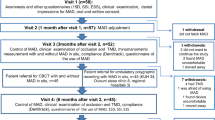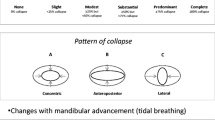Abstract
Purpose
Flow–volume curves have been shown to relate to upper airway physiology during sleep and may be useful for predicting the response to treatment of obstructive sleep apnea (OSA) with mandibular advancement splints (MAS). The aim of this study was to prospectively assess the potential clinical utility of a previously derived prediction method using flow–volume curves performed during wakefulness.
Methods
Patients with newly diagnosed OSA interested in undertaking treatment with a custom-made MAS were approached to participate in the study. Response to treatment was defined by a 50% or greater reduction in the apnea–hypopnea index. Flow–volume curves were performed in the erect position prior to construction of the MAS.
Results
Flow–volume curves were performed in 35 patients. Of these, 25 patients were responders, and 10 patients were non-responders. A combined cut-off of an inspiratory flow rate at 50% of vital capacity (MIF50) less than 6.0 L/s and a ratio of the expiratory flow rate at 50% of vital capacity to MIF50 of greater than 0.7 correctly classified 48.6% of the patients. It had a sensitivity of 36.0%, specificity of 80.0%, positive predictive value of 81.8%, and negative predictive value of 33.3%.
Conclusions
These results suggest that the previously derived prediction model, using flow–volume curves performed during wakefulness, was not sufficient to reliably predict the response to treatment of OSA with MAS. A combination of a functional assessment using flow–volume curves and a structural evaluation of the upper airway with imaging modalities may result in a prediction model with better performance characteristics.

Similar content being viewed by others
References
Ferguson KA, Cartwright R, Rogers R, Schmidt-Nowara W (2006) Oral appliances for snoring and obstructive sleep apnea: a review. Sleep 29:244–262
Ng AT, Qian J, Cistulli PA (2006) Oropharyngeal collapse predicts treatment response with oral appliance therapy in obstructive sleep apnea. Sleep 29:666–671
Mehta A, Qian J, Petocz P, Darendeliler MA, Cistulli PA (2001) A randomized, controlled study of a mandibular advancement splint for obstructive sleep apnea. Am J Respir Crit Care Med 163:1457–1461
Marklund M, Stenlund H, Franklin KA (2004) Mandibular advancement devices in 630 men and women with obstructive sleep apnea and snoring: tolerability and predictors of treatment success. Chest 125:1270–1278
Liu Y, Lowe AA, Fleetham JA, Park YC (2001) Cephalometric and physiologic predictors of the efficacy of an adjustable oral appliance for treating obstructive sleep apnea. Am J Orthod Dentofacial Orthop 120:639–647
Chan AS, Schwab RJ, Zeng B, Lee RW, Darendeliler MA, Pack AI, Cistulli PA (2008) Mandibular advancement splints and upper airway anatomy in obstructive sleep apnea [abstract]. Am J Respir Crit Care Med 177:A939
Chan ASL, Lee RWW, Srinivasan VK, Darendeliler MA, Grunstein RR, Cistulli PA (2010) Nasopharyngoscopic evaluation of oral appliance therapy for obstructive sleep apnoea. Eur Respir J 35:836–842
Rauscher H, Popp W, Zwick H (1990) Flow-volume curves in obstructive sleep apnea and snoring. Lung 168:209–214
Krieger J, Weitzenblum E, Vandevenne A, Stierle JL, Kurtz D (1985) Flow-volume curve abnormalities and obstructive sleep apnea syndrome. Chest 87:163–167
Liam CK, Lim KH, Wong CM, Lau WM, Tan CT (2001) Awake respiratory function in patients with the obstructive sleep apnoea syndrome. Med J Malays 56:10–17
Shore ET, Millman RP (1984) Abnormalities in the flow-volume loop in obstructive sleep apnoea sitting and supine. Thorax 39:775–779
Ng A, Zeng B, Qian J, Cistulli P (2006) Relationship between site of upper airway collapse during sleep and flow–volume curves in predicting treatment outcome with oral appliances in obstructive sleep apnoea [abstract]. Proc Am Thorac Soc 3:A869
Zeng B, Ng AT, Darendeliler MA, Petocz P, Cistulli PA (2007) Use of flow-volume curves to predict oral appliance treatment outcome in obstructive sleep apnea. Am J Respir Crit Care Med 175:726–730
Bleeker SE, Moll HA, Steyerberg EW, Donders ART, Derksen-Lubsen G, Grobbee DE, Moons KGM (2003) External validation is necessary in prediction research: a clinical example. J Clin Epidemiol 56:826–832
American Thoracic Society (1995) Standardization of spirometry, 1994 update. Am J Respir Crit Care Med 152:1107–1136
Zeng B, Ng AT, Qian J, Petocz P, Darendeliler MA, Cistulli PA (2008) Influence of nasal resistance on oral appliance treatment outcome in obstructive sleep apnea. Sleep 31:543–547
Gotsopoulos H, Chen C, Qian J, Cistulli PA (2002) Oral appliance therapy improves symptoms in obstructive sleep apnea: a randomized, controlled trial. Am J Respir Crit Care Med 166:743–748
Pitsis AJ, Darendeliler MA, Gotsopoulos H, Petocz P, Cistulli PA (2002) Effect of vertical dimension on efficacy of oral appliance therapy in obstructive sleep apnea. Am J Respir Crit Care Med 166:860–864
Gotsopoulos H, Kelly JJ, Cistulli PA (2004) Oral appliance therapy reduces blood pressure in obstructive sleep apnea: a randomized, controlled trial. Sleep 27:934–941
American Sleep Disorders Association (1992) EEG arousals: scoring rules and examples: a preliminary report from the Sleep Disorders Atlas Task Force of the American Sleep Disorders Association. Sleep 15:173–184
Rechtschaffen A, Kales A (1968) A manual of standardized terminology, techniques and scoring system for sleep stages of human subjects. Brain Information Service/Brain Research Institute, University of California, Los Angeles, CA
Acknowledgements
The authors are grateful to Dr Biao Zeng and the sleep laboratory staff for their assistance.
Conflict of interest statement
PAC contributed to the development of the oral appliance used in this study, which is being commercialized by SomnoMed Ltd. He previously served as a consultant and medical advisory board member (2004–2006, AUD$5,000 per annum), and has a pecuniary interest in the company. His department receives equipment (oral appliances) and financial support (2009, AUD$60,000) for research studies from SomnoMed Ltd. PAC is a chief investigator in a CPAP clinical trial funded by ResMed Inc, and his department receives equipment support (CPAP machines) for investigator-initiated studies. He is a board member of the ResMed Foundation, a non-profit charitable organization. MAD’s travel and expenses to the German Dental and Medical Sleep Meeting in Regensburg, Germany were sponsored by SomnoMed Ltd in 2006. Support in-kind for this study (mandibular advancement splints) was provided by SomnoMed Ltd.
Author information
Authors and Affiliations
Corresponding author
Additional information
This study is supported by the National Health and Medical Research Council of Australia (Medical Postgraduate Scholarship No. 457155)
Rights and permissions
About this article
Cite this article
Chan, A.S.L., Lee, R.W.W., Srinivasan, V.K. et al. Use of flow–volume curves to predict oral appliance treatment outcome in obstructive sleep apnea: a prospective validation study. Sleep Breath 15, 157–162 (2011). https://doi.org/10.1007/s11325-010-0395-7
Received:
Revised:
Accepted:
Published:
Issue Date:
DOI: https://doi.org/10.1007/s11325-010-0395-7




